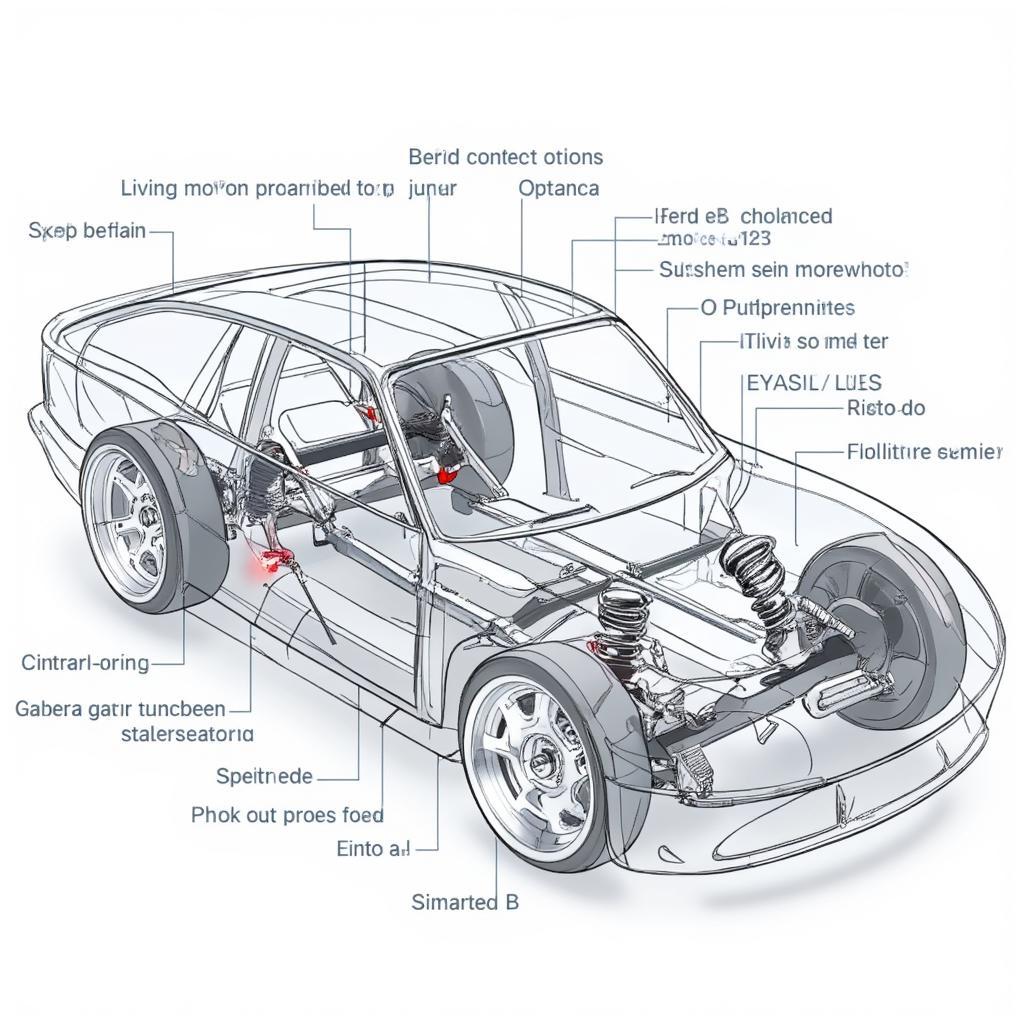Decoding Automotive Electrical System Repair: A Comprehensive Guide

The intricate dance of electrons within your vehicle is what brings it to life – from the spark that ignites the engine to the dashboard lights illuminating your journey. Understanding and addressing issues within the Automotive Electrical System Repair is crucial for any car owner. This guide delves into the core of this often-misunderstood area, providing practical insights and expert advice.
Modern vehicles are heavily reliant on their electrical systems, a complex network of wires, sensors, and control units working in harmony. A malfunction in this system can manifest in various ways, from a simple blown fuse to more complex issues affecting the engine, brakes, or safety features. Ignoring these signs can lead to more significant and costly repairs down the road.
Understanding the Basics of Automotive Electrical Systems
Before tackling any repair, it’s essential to grasp the fundamental components of your vehicle’s electrical system. These components work together to power everything from the starter motor to the infotainment system:
- The Battery: The heart of the electrical system, providing the initial power to start the engine and run electrical accessories.
- The Alternator: Recharges the battery while the engine is running, keeping the electrical system powered.
- Fuses and Relays: Act as protective devices, preventing damage from excessive current flow.
- Wiring Harnesses: Bundles of wires that transmit electrical signals throughout the vehicle.
- Sensors: Monitor various vehicle functions and provide input to the control modules.
- Control Modules (ECUs): The “brain” of the system, processing sensor data and controlling various components.
Understanding how these components interact is the first step in effectively addressing electrical system issues.
Common Electrical Problems You Might Encounter
Electrical issues can be frustrating, but knowing the signs can help diagnose and address them promptly. Here are a few common problems:
- Dead Battery: Often caused by leaving lights on, a faulty alternator, or a parasitic drain.
- Starting Issues: Can stem from a weak battery, a faulty starter, or a problem with the ignition system.
- Dimming Lights: May indicate a weak alternator or a poor electrical connection.
- Malfunctioning Sensors: Can trigger error lights or lead to incorrect readings.
- Fuse Problems: Usually a sign of an electrical overload or short circuit.
These issues, when left unaddressed, could lead to more complex problems that could render your vehicle unusable. As automotive technology advances, understanding the intricate electrical landscape of a modern vehicle is becoming paramount. If you’re considering a career path that involves working on these complex systems, exploring avenues like the automotive technician associate’s degree salary could be a beneficial first step.
Diagnosing Electrical Issues: A Step-by-Step Approach
Before jumping into repairs, it’s important to accurately diagnose the problem. Here’s how to approach it:
- Gather Information: Start by noting down any symptoms you’re experiencing. When did the problem start? Are there any other symptoms present? The more details you gather, the easier the diagnosis will be.
- Visual Inspection: Check for any obvious signs of damage, such as frayed wires, corroded connections, or blown fuses.
- Use a Multimeter: A multimeter is an essential tool for testing electrical circuits. Use it to check voltage, current, and resistance values.
- Check for Error Codes: Most modern vehicles have an On-Board Diagnostics (OBD) system that stores error codes. Use an OBD scanner to retrieve these codes, which can pinpoint the problem area.
- Consult a Wiring Diagram: If you’re dealing with a complex issue, a wiring diagram can be invaluable. It shows you how the different parts of the electrical system are connected.
- Start with the Simplest Possibilities: Begin by checking the battery terminals, fuses, and relays. Often the problem lies with a simple component before moving onto the more complex diagnostics.
“Effective diagnosis is the cornerstone of any successful automotive electrical repair,” says Dr. Eleanor Vance, a veteran automotive electrical engineer. “It’s not about replacing parts randomly; it’s about understanding the system and locating the root cause of the issue.”
This methodical approach will help you narrow down the issue and avoid unnecessary repairs.
Tools of the Trade: Essential Equipment for Electrical Repair
Having the right tools makes automotive electrical repair far easier and safer. Here’s a rundown of essential tools:
- Multimeter: For measuring voltage, current, and resistance.
- OBD-II Scanner: To read and clear diagnostic trouble codes.
- Wire Strippers: For removing insulation from wires.
- Crimpers: To securely connect wires.
- Test Light: For quickly checking power and ground connections.
- Wiring Diagrams: For understanding circuit layouts.
- Pliers and Screwdrivers: For disassembly and assembly.
- Heat Shrink Tubing: For insulating connections.
- Soldering Iron and Solder: For creating permanent connections.

Having a well-equipped toolkit is critical to performing effective repairs. It’s also worth noting that training and access to reliable information, such as a modern automotive technology textbook, can significantly improve your skillset.
When Should You Seek Professional Help?
While some electrical repairs can be tackled by a DIY enthusiast, there are situations where a professional is essential:
- Complex Issues: Problems with control modules (ECUs), ABS, or airbag systems often require specialized knowledge and equipment.
- Intermittent Issues: These can be difficult to trace and often require advanced diagnostic techniques.
- Safety Concerns: If you are unsure how to safely work with the electrical system or suspect an issue with the vehicle’s safety systems, seek professional advice.
- Lack of Necessary Equipment: If you don’t have access to specialized tools or diagnostic equipment, it may be wiser to take it to an experienced mechanic.
It’s important to be honest about your skill level. Attempting a repair beyond your capabilities could create further damage to the electrical system, resulting in higher repair bills. For those passionate about automotive technology, it’s beneficial to keep up with the latest resources, like the automotive technology book 7th edition , to understand the evolving trends.
Preventing Electrical Problems: Proactive Maintenance
Prevention is often better than cure, and this applies to your car’s electrical system as well. Here are some maintenance tips to help minimize electrical issues:
- Regular Battery Checks: Keep the battery terminals clean and free from corrosion, checking voltage and electrolyte levels as necessary.
- Secure Connections: Ensure all electrical connections are tight and free from damage.
- Replace Fuses with the Correct Rating: Always replace blown fuses with ones that have the correct amperage rating.
- Avoid Overloading Circuits: Be careful when using after-market electrical devices that may overload circuits.
- Professional Inspections: Have your electrical system inspected by a qualified mechanic during routine maintenance checks.
By following these preventative steps, you can significantly reduce the likelihood of experiencing unexpected electrical problems and keeping your vehicle running at its best.
Future of Automotive Electrical Systems: Emerging Trends
The automotive industry is rapidly evolving, with electric and hybrid vehicles gaining popularity. This evolution means the electrical systems are becoming even more intricate and essential. Here are some emerging trends:
- Increased Complexity: Electric and hybrid vehicles utilize more complex electrical systems than traditional gasoline-powered cars.
- Advanced Driver-Assistance Systems (ADAS): These rely heavily on electrical sensors and control systems.
- Increased Integration: Electrical systems are becoming increasingly integrated with the vehicle’s overall control and communication networks.
- Data-Driven Diagnostics: Utilizing data from the vehicle to diagnose issues in real-time is becoming more prevalent.
“The future of automotive repair lies in mastering the ever-complex electrical systems of modern vehicles,” explains Joseph Martinez, a leading researcher in automotive electronics. “Staying ahead of these technological changes is key to keeping vehicles safe and efficient on the road.”
Understanding these trends is crucial for anyone working in the automotive industry. Moreover, programs such as epcc automotive technology can offer valuable insights into cutting-edge technologies and best practices within the field.
A Career in Automotive Electrical System Repair
For those passionate about cars and technology, a career in automotive electrical system repair can be very rewarding. This field is always evolving and offers an opportunity to work with cutting-edge technology. A solid start could be achieved by obtaining a cert 2 automotive servicing technology, which provides fundamental skills and knowledge. Additionally, consider these to further a career in this area:
- Formal Training: Attend vocational schools or colleges that offer programs in automotive electrical repair.
- Certifications: Pursue certifications from reputable organizations that validate your knowledge and skills.
- Hands-On Experience: Seek out internships or apprenticeships to gain practical experience.
- Continuous Learning: Stay up to date with the latest trends and technologies by attending workshops, seminars, and online courses.
- Develop Diagnostic Skills: Mastering the art of diagnostics will significantly improve efficiency in resolving issues.
The field offers opportunities for those with technical aptitude, problem-solving skills and a passion for cars.
Conclusion
Mastering automotive electrical system repair requires a mix of theoretical knowledge, practical skills, and a systematic approach. By understanding the basics, using the right tools, and approaching problems systematically, you can keep your vehicle’s electrical system running smoothly. Whether you choose to handle simpler issues yourself or seek professional help, continuous learning and preventative maintenance are the keys to ensuring your vehicle’s electrical system remains reliable for years to come. As the automotive world becomes increasingly reliant on electronics, the demand for skilled professionals in this field will only continue to grow.
Frequently Asked Questions
-
What are the most common signs of an electrical problem in a car?
Common signs include dimming lights, a dead battery, starting issues, malfunctioning sensors, and frequently blown fuses. These symptoms indicate a potential issue requiring further investigation and potential repair. -
Can I diagnose an electrical problem in my car myself?
Yes, you can perform basic diagnostics with a multimeter and OBD-II scanner, but complex issues might require a professional with advanced knowledge and specialized equipment. Start with simple troubleshooting before tackling complicated issues. -
What tools are necessary for automotive electrical repair?
Essential tools include a multimeter, OBD-II scanner, wire strippers, crimpers, test light, wiring diagrams, and basic hand tools. Having these tools handy can help diagnose and repair most electrical issues. -
How can I prevent electrical problems in my car?
Regularly check the battery, secure electrical connections, replace fuses with the correct rating, avoid overloading circuits, and have professional inspections done. Preventative maintenance greatly reduces the risk of unexpected electrical failures. -
What is the function of the alternator in a car?
The alternator recharges the battery while the engine is running, ensuring the vehicle’s electrical system is powered. A faulty alternator can lead to a dead battery and various electrical malfunctions. -
What does an ECU (Engine Control Unit) do in a car’s electrical system?
The ECU is the ‘brain’ of the system, processing data from sensors and controlling various vehicle functions, ensuring efficient operation. Issues with the ECU often require specialized diagnostics and repairs. -
When is it necessary to seek professional help for car electrical problems?
You should seek professional help for complex issues, intermittent problems, safety concerns, or when you lack the necessary equipment and experience to complete a repair safely. Consulting an expert will prevent further damage and ensure proper functioning. -
How often should a car’s electrical system be professionally inspected?
A professional inspection is recommended during routine maintenance checks, typically every 12 to 24 months or when you encounter any electrical system-related issues. Regular checks help identify and address potential issues early on. -
What are some of the latest advancements in automotive electrical systems?
New advancements include increased complexity in electric and hybrid vehicles, advanced driver-assistance systems (ADAS), and greater data-driven diagnostics, creating new challenges and opportunities for automotive professionals.




